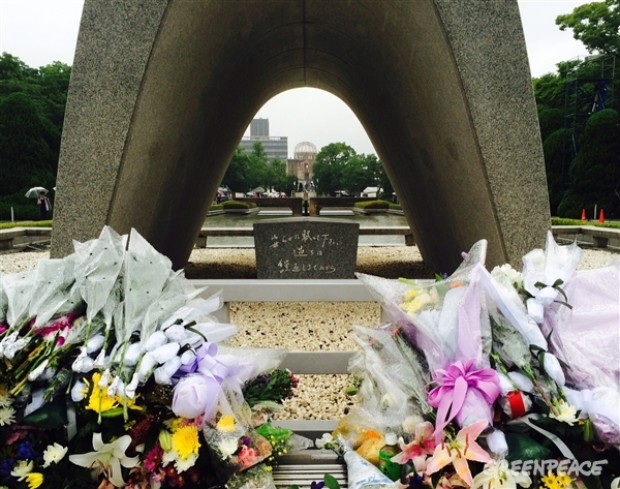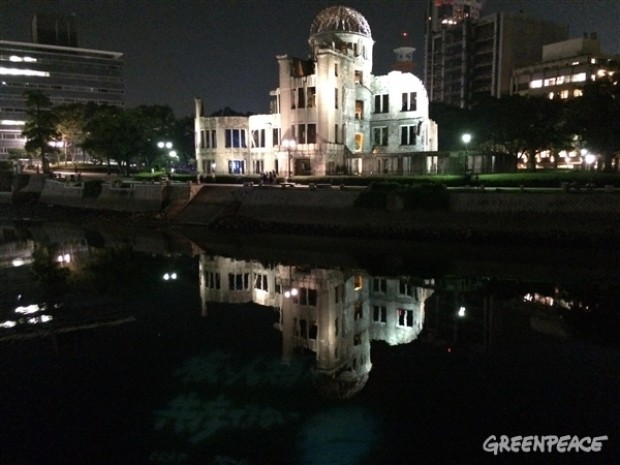What my grandmother would say about President Obama’s visit to Hiroshima

World leaders are meeting in Japan for the G7, but on a side trip, President Obama is doing something no sitting US president has done before: visit Hiroshima. The city was flattened during World War Two by the first nuclear weapon used in warfare. Now more than ever, we need leadership to make sure that history doesn’t repeat itself. We need to go nuclear-free.
The people of Hiroshima have waited nearly 71 years for a sitting US president to visit their city, and witness the scars from the first nuclear bomb ever used in war.
My grandmother won’t be there to welcome Mr Obama as she no longer lives in the city. She is a Hibakusha, one of the survivors of the bomb who was exposed to its radiation. For the past few years, I’ve been listening to the stories of the Hibakusha after attending a peace ceremony in Hiroshima in 2013 and hearing one of the survivors tell her story. She begged me: “Please, listen to my story while I am still alive”.
There were nearly 16,000 children in Hiroshima when the bomb dropped. Thousands of others had been evacuated to the surrounding countryside. But they were all affected. Some died instantly, others days or weeks later from radiation poisoning. Many of those who were spared the bombing lost their families. They became known as the A-bomb orphans, and there were 6,500 in Hiroshima alone after the war.
Peace Memorial Museum testimonies
If you go to the museum of the bombing in Hiroshima or Nagasaki, you can listen to the voices of those who were there.
“The world was dark. There was nothing. People lay dying in the streets, their heads soaked in water because of the burning. There were dead horses. Dogs, cats and birds had all disappeared. After the bombing, people kept dying. A smell like fish filled the town.”

Photo provided by Mr. Noboru Katayama
The people in this photo lived in Nakajima-honmachi, the place that is now the Hiroshima Memorial Peace Park. They all died in the bombing.
When you examine the photo, you see only women and young children, those who could not be evacuated to the countryside. Most of the men were enlisted as soldiers. About 90% of the people remaining in Hiroshima were women, children and the elderly.
The people in this photo were at Ground Zero when the bomb dropped. The flash from the blast sent temperatures as high as 3,000 degrees C, completely obliterating them. There were no bodies to recover.
The suffering of survivors
A survivor of the bombing, Tadamichi Hirata remembers his mother’s words: “I want this war to finish. I want us to live together as a family.”
This wish was never granted. The mother and her younger child died in the bombing.
Some of the survivors, even now, do not want to talk about what happened to them. Their suffering didn’t end with the bombing. Thousands died of radiation sickness after the war. Others faced years of discrimination in employment and marriage because of fears of the radiation they had suffered.
My grandmother also didn’t talk much about those terrible moments. But when she did, her words were very simple “Everything collapsed. Every living creature perished. We should never make such a big mistake again.”
If she had been able to be at Hiroshima for Mr Obama’s visit, I think that is what she would have told him. And I hope it is what other survivors tell him.
There has been a lot of talk about an apology. But stronger than an apology, I think, would be the words “Never again”.

President Obama has made a courageous step to come to Hiroshima. But the US, which still has 4,700 operational nuclear warheads, is not learning from the mistakes of the past. Rather than rid the world of nuclear weapons, President Obama’s administration has proposed a US$1 trillion plan to update and expand his country’s nuclear arsenal over the next 30 years. That’s at the same time the US is cutting funding for nonproliferation efforts.
No more. It’s time we reimagine global security not around war, but on peace. As my grandmother told me: “We should never make such a big mistake again”.
No more Hiroshimas, no more Nagasakis, no more war.
Daisuke Miyachi, is a former staff member at Greenpeace Japan. Shortly after the accident at the Fukushima Daiichi nuclear power plant, he was part of Greenpeace’s radiation team checking radiation levels in Fukushima. He is originally from Hiroshima and has been working as a storyteller – remembering and recounting the stories of victims of the atomic bombs.
If you would like to hear more about Greenpeace UK’s peace and disarmament work then please join the campaign network here.
